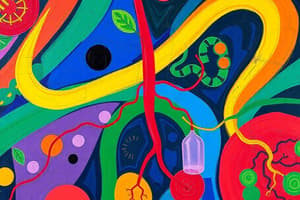Podcast
Questions and Answers
What is the primary purpose of cellular respiration?
What is the primary purpose of cellular respiration?
- To consume oxygen
- To release energy from glucose (correct)
- To create carbon dioxide
- To produce glucose
What molecule is primarily produced during cellular respiration for energy?
What molecule is primarily produced during cellular respiration for energy?
- Oxygen
- ATP (correct)
- Carbon Dioxide
- Glucose
Which of the following is consumed during photosynthesis?
Which of the following is consumed during photosynthesis?
- ATP
- Oxygen
- Glucose
- Carbon Dioxide (correct)
Which of the following produces oxygen?
Which of the following produces oxygen?
Which process occurs in all living organisms?
Which process occurs in all living organisms?
Which of the following contains the cytosol and the organelles?
Which of the following contains the cytosol and the organelles?
Which process is light dependent?
Which process is light dependent?
If the reactants for photosynthesis are carbon dioxide and water, what are the products?
If the reactants for photosynthesis are carbon dioxide and water, what are the products?
What is the net yield of ATP molecules from a single glucose molecule undergoing glycolysis?
What is the net yield of ATP molecules from a single glucose molecule undergoing glycolysis?
In what part of the cell does glycolysis take place?
In what part of the cell does glycolysis take place?
What type of molecule is pyruvate?
What type of molecule is pyruvate?
After glycolysis, pyruvate enters which process?
After glycolysis, pyruvate enters which process?
What is ATP?
What is ATP?
What happens when ATP releases energy?
What happens when ATP releases energy?
What role does $NAD^+$ play in respiration?
What role does $NAD^+$ play in respiration?
What is the reduced form of $NAD^+$?
What is the reduced form of $NAD^+$?
Which molecule is produced during respiration and used by cells for energy?
Which molecule is produced during respiration and used by cells for energy?
In the context of respiration, to what does oxidation refer?
In the context of respiration, to what does oxidation refer?
Which of the following is the first step in both aerobic and anaerobic respiration?
Which of the following is the first step in both aerobic and anaerobic respiration?
Where does glycolysis take place in the cell?
Where does glycolysis take place in the cell?
What is produced when glucose is converted during glycolysis?
What is produced when glucose is converted during glycolysis?
Which type of respiration requires oxygen?
Which type of respiration requires oxygen?
Which of the following is a characteristic of anaerobic respiration?
Which of the following is a characteristic of anaerobic respiration?
What is the usable form that pyruvate is converted into before entering the mitochondrial matrix?
What is the usable form that pyruvate is converted into before entering the mitochondrial matrix?
In aerobic respiration, which cycle is also known as the citric acid cycle?
In aerobic respiration, which cycle is also known as the citric acid cycle?
Where does the electron transport chain occur in eukaryotes?
Where does the electron transport chain occur in eukaryotes?
What molecules carry electrons to the electron transport chain?
What molecules carry electrons to the electron transport chain?
What is the final electron acceptor in the electron transport chain?
What is the final electron acceptor in the electron transport chain?
Approximately how many ATP molecules are generated by the electron transport chain from each glucose molecule?
Approximately how many ATP molecules are generated by the electron transport chain from each glucose molecule?
What is the first step in both aerobic and anaerobic respiration?
What is the first step in both aerobic and anaerobic respiration?
What is the process of extracting energy from pyruvate in the absence of oxygen called?
What is the process of extracting energy from pyruvate in the absence of oxygen called?
What causes bread to rise when using yeast in baking?
What causes bread to rise when using yeast in baking?
Which process does NOT occur during anaerobic respiration?
Which process does NOT occur during anaerobic respiration?
What is the primary reason for the low ATP yield in fermentation?
What is the primary reason for the low ATP yield in fermentation?
Which of the following is a product of anaerobic respiration?
Which of the following is a product of anaerobic respiration?
What is a zygote?
What is a zygote?
What happens to the alcohol produced during bread baking?
What happens to the alcohol produced during bread baking?
What is the term for twins that originate from one egg and one sperm?
What is the term for twins that originate from one egg and one sperm?
When does fermentation provide a quick burst of necessary energy?
When does fermentation provide a quick burst of necessary energy?
What does it mean to be a carrier of a recessive gene?
What does it mean to be a carrier of a recessive gene?
How many ATP molecules are produced during glycolysis in anaerobic respiration?
How many ATP molecules are produced during glycolysis in anaerobic respiration?
Which of the following is absent during anaerobic respiration?
Which of the following is absent during anaerobic respiration?
Which of the following is a dominant trait example?
Which of the following is a dominant trait example?
What are alleles?
What are alleles?
Flashcards
Cellular Respiration
Cellular Respiration
Process of breaking down glucose to release energy.
Photosynthesis
Photosynthesis
It produces food (glucose).
Cytosol
Cytosol
The fluid (and suspended molecules) around the organelles.
Cytoplasm
Cytoplasm
Signup and view all the flashcards
Cellular Respiration
Cellular Respiration
Signup and view all the flashcards
Cellular Respiration
Cellular Respiration
Signup and view all the flashcards
Photosynthesis
Photosynthesis
Signup and view all the flashcards
Photosynthesis & Cellular Respiration Relationship
Photosynthesis & Cellular Respiration Relationship
Signup and view all the flashcards
Aerobic Respiration
Aerobic Respiration
Signup and view all the flashcards
Anaerobic Respiration
Anaerobic Respiration
Signup and view all the flashcards
Glycolysis
Glycolysis
Signup and view all the flashcards
Oxidation
Oxidation
Signup and view all the flashcards
Glycolysis Definition
Glycolysis Definition
Signup and view all the flashcards
Glycolysis Location
Glycolysis Location
Signup and view all the flashcards
Pyruvate
Pyruvate
Signup and view all the flashcards
ATP (Adenosine Triphosphate)
ATP (Adenosine Triphosphate)
Signup and view all the flashcards
NADH
NADH
Signup and view all the flashcards
NAD+
NAD+
Signup and view all the flashcards
Reduction
Reduction
Signup and view all the flashcards
Glucose Breakdown
Glucose Breakdown
Signup and view all the flashcards
Electron Transport Chain (ETC)
Electron Transport Chain (ETC)
Signup and view all the flashcards
Acetyl-CoA
Acetyl-CoA
Signup and view all the flashcards
Citric Acid Cycle
Citric Acid Cycle
Signup and view all the flashcards
"Prep" Stage (Acetyl-CoA Production)
"Prep" Stage (Acetyl-CoA Production)
Signup and view all the flashcards
Fermentation
Fermentation
Signup and view all the flashcards
Carrier (Genetics)
Carrier (Genetics)
Signup and view all the flashcards
Zygote
Zygote
Signup and view all the flashcards
Monozygotic Twins
Monozygotic Twins
Signup and view all the flashcards
Dizygotic Twins
Dizygotic Twins
Signup and view all the flashcards
Allele
Allele
Signup and view all the flashcards
Anaerobic Respiration Products
Anaerobic Respiration Products
Signup and view all the flashcards
Why Bread Rises
Why Bread Rises
Signup and view all the flashcards
Lactate Removal
Lactate Removal
Signup and view all the flashcards
Anaerobic Respiration Pathway
Anaerobic Respiration Pathway
Signup and view all the flashcards
ATP Production in Anaerobic Respiration
ATP Production in Anaerobic Respiration
Signup and view all the flashcards
Incomplete Glucose Breakdown
Incomplete Glucose Breakdown
Signup and view all the flashcards
Purpose of Fermentation
Purpose of Fermentation
Signup and view all the flashcards
Aerobic vs. Anaerobic ATP Production
Aerobic vs. Anaerobic ATP Production
Signup and view all the flashcards
Study Notes
- General Biology 2 covers cellular respiration and genetics/heredity
Cellular Respiration
- Cellular respiration breaks down glucose molecules to release energy.
- It is a series of chemical reactions which produces ATP, which cells use for energy.
Photosynthesis vs. Cellular Respiration
- Photosynthesis produces glucose and energy, and consumes carbon dioxide.
- Photosynthesis releases oxygen and is light-dependent, occuring only in plants.
- Cellular respiration consumes glucose and oxygen, releasing energy and carbon dioxide.
- Cellular respiration is light-independent and occurs in all living organisms.
Clarification of Terms
- Cytosol is the fluid containing salts, sugar, amino acids, and enzymes around the organelles.
- Cytoplasm is the cytosol plus the organelles, essentially everything in the cell except the nucleus.
- Cell is comprised of the plasma membrane, cytoplasm, and nucleus.
Definition
- Cellular respiration can be considered the opposite process of photosynthesis.
- It transforms food energy into chemical energy in the form of ATP.
- Both plants and animals undergo the process of cellular respiration.
Reactants and Products
- Cellular respiration appears to be the reverse of photosynthesis, where the reactants of one process are the products of the other.
- Steps of cellular respiration are not simply the reverse of photosynthesis.
Reaction Formula
- Glucose is combined with six oxygen molecules.
- This results in six carbon dioxide molecules, six water molecules, and ATP molecules.
Types of Cellular Respiration
- Anaerobic respiration occurs without oxygen.
- Aerobic respiration requires oxygen.
- Aerobic respiration produces 36 ATP molecules per glucose molecule.
- Anaerobic respiration produces only 2 ATP molecules.
- Some organisms can only perform anaerobic respiration.
- Anaerobic respiration releases energy from food molecules in the absence of oxygen.
- Anaerobic respiration yields different products depending on the organism.
- Yeast produces ethanol and carbon dioxide.
- Animal muscle cells produce lactic acid.
- Aerobic respiration produces more ATP than anaerobic respiration.
Aerobic Respiration
- Cellular respiration is the process by which glucose molecules are broken down to release energy.
- It's a series of chemical reactions that produces ATP.
- Most cellular processes use ATP for energy.
3 Steps of Aerobic Respiration
- Glycolysis
- Krebs Cycle
- Electron Transport
Glycolysis
- Glycolysis occurs in the cytoplasm and is the first step in both aerobic and anaerobic respiration.
- It is universal in organisms, suggesting it evolved before the Krebs cycle and electron transport system.
- Glycolysis converts glucose to pyruvate and releases energy.
- Pyruvate is a three-carbon molecule that enters the Krebs cycle.
- Glycolysis is a ten-step process with intermediate products at each step.
- Both aerobic and anaerobic respiration always begin with glycolysis.
- Glycolysis splits glucose and yields a small amount of energy as ATP and NADH and converts one molecule of glucose into two molecules of pyruvate.
Oxidation
- Oxidation in respiration occurs when glucose is oxidized and energy is released as ATP.
- Oxidation is combining a molecule with oxygen.
- ADP is further oxidized into pyruvate.
- Oxidation process is when a molecule loses an electron, gains an oxygen molecule, or loses a hydrogen molecule.
- Reduction process is when a molecule gains an electron, or has the addition of hydrogen or removal of oxygen.
Energy Currency
- Adenosine triphosphate (ATP) is the major energy source of the cell.
- Energy is released from the conversion of ATP to adenosine diphosphate (ADP).
- ATP is the immediate source of energy in a cell.
NADH
- A single glucose molecule undergoing glycolysis yields two NADH, two ATP, and two pyruvate molecules.
- Only 2% of the chemical energy contained in a glucose molecule is released by glycolysis.
- Most of the remaining chemical energy is in the pyruvate molecules and is released in the Krebs cycle.
Breakdown of Glucose
- Reactions breaking down a glucose molecule into pyruvate
- Pyruvate are two 3-carbon molecules.
- The process yields 2 ATP molecules and 2 NADH per molecule of glucose that is broken down
- Cells uses 2 ATP molecules as a source of energy to break down glucose to pyruvate.
Krebs Cycle
- Glycolysis occurs during both anaerobic and aerobic respiration.
- Only 2 NADH molecules are produced during glycolysis.
- Krebs Cycle requires oxygen and occurs in the mitochondrial matrix.
- The Krebs cycle is aerobic.
- Two molecules of acetyl-CoA from each glucose molecule require two Krebs cycle turns, yielding four CO2, six NADH, two FADH2, and two ATPs.
- The acetyl group of acetyl-CoA is oxidized to form two molecules of CO2 and one ATP.
- This step occurs twice for every original glucose molecule entering.
- Pyruvate molecules produced in glycolysis are transformed into acetyl-CoA, which enter the Krebs cycle, breaking down acetyl-CoA to form CO2, ATP, NADH, and FADH.
- The prep stage sees pyruvate oxidized to form Acetyl-CoA.
- The Krebs Cycle it is a set of reactions that break down acetyl-CoA to form CO2, ATP, NADH, and FADH. -The cycle is also called the citric acid cycle because citric acid is formed in the first reaction.
Electron Transport Chain
- The electron transport chain is the third step in aerobic respiration.
- It occurs in the inner membrane of the mitochondria.
- Most of the remaining energy is in electrons carried by NADH and FADH2.
- The energy from electrons must be converted to ATP before cells can use it.
- Energy is transferred from NADH and FADH2 to ATP.
- This phase of aerobic respiration requires oxygen to move electrons from NADH and FADH2 along the electron transport chain in the inner membrane of the mitochondrion.
- Electrons that have become "excited" are moved to the ETC by carriers, such as NADH and FADH2
- Energy is released when hydrogen ions flow back through the mitochondrial membrane.NAD+, FAD, water, and 32-34 ATPs
- Electron transport chain releases products NAD+, FAD, water, and 32-34 ATPs.
- All organisms have mechanisms for removing carbon dioxide, which can kill cells at high levels
Total ATPs
- Represents less than half the chemical energy in one glucose molecule.
- Enough energy is collected for humans and all other aerobic organisms to live.
Glycolysis & Aerobic Respiration
- Glycolysis is the first step in both aerobic and anaerobic respiration.
- The electron transport chain steps are located in aerobic respiration.
- Acetyl-CoA is produced in the “prep" stage of aerobic respiration from the pyruvate molecule.
Anaerobic Respiration
- Fermentation is the process that extracts energy from pyruvate in the absence of oxygen.
- Muscle cells can produce energy without oxygen and some organisms can also break down carbohydrates without oxygen.
Two Types of Fermentation
- Alcoholic fermentation.
- Lactic acid fermentation.
- Alcoholic fermentation is carried out by yeast and some bacteria and results in ethanol and CO2.
- Carbon dioxide trapped during alcoholic fermentation causes bread to rise.
- Lactic acid fermentation is carried out by muscles when not enough oxygen is absorbed, and also occurs in bacteria found in yogurt.
- The process results in lactic acid.
General Info
- Both aerobic and anaerobic respiration begin with glycolysis.
- During anaerobic, only 2 molecules of ATP are produced in the first step, glycolysis.
- The low ATP yield in fermentation because the glucose molecule is not completely broken down or metabolized.
- Fermentation doesn't break down glucose to its full energy potential.
- It provides quick energy when oxygen cannot reach cells fast enough.
ALCOHOLIC FERMENTATION
- Alcoholic fermentation is used to make breads, yeasts break down the carbohydrates in dough, CO2 is produced and trapped in the dough which makes it rise
- Alcohol evaporates and yeasts die as the dough bakes.
- Alcoholic fermentation is used to make wine, etc.
LACTIC ACID FERMENTATION
- Lactate is removed by oxygen cells in the blood.
- It causes soreness after strenuous activity.
- During anaerobic, OXYGEN is ABSENT.
- Ethanol, CO2 and Lactic Acid Products of anaerobic respiration
- AEROBIC produces more ATP molecules.
Genetics & Heredity
- Genetics is the study of how animals and plants pass on traits such as eye color, hair color, height, body build, blood types, intelligence, and gender to their offspring.
- Heredity is the characteristics a child receives from both parents.
- Cell is the basic unit of life
- Cytoplasm is the substance of a cell outside of the nucleus.
- Nucleus is the central point containing a genetic coding and maintains growth.
- Chromosomes are 46 in each nucleus.
- Genes are bands on chromosomes (thousands of genes).
- DNA is on genes (billions of DNA).
- Each cell has 46 chromosomes or 23 pairs.
- Reproductive cells have 23 chromosomes.
Cell Division
- Mitosis-cell division is the copying the DNA.
- Meiosis creates 1/2 sets.
- Women chromosomes are 23X.
- Men chromosomes are 23.
- Gender is determined by the father.
Genes and Traits
- Dominant gene-trait is more powerful.
- Recessive characteristic gene is weaker and hides in the background.
- Carrier has a recessive trait gene that is not visible.
Multiple Births
- Zygote contains two sperm to fertilize the egg
- Monozygote divides and separates
- Dizygote is two or more twins
- Conjoined twins has an ovum splits but separation is not completed.
Factors to Multiple Births
- History
- Increased hormones
- Fertility Drugs
- Age
Mendel's Law
- Born in Czechoslovakia
- Became a monk in 1843
- Taught interest in statistics at University of Vienna
- Famous for his work with pea plants
- In between discovered plants and tested them
- Allele has many different traits
- Dominant always expresses the trait
- Recessive only shows and represents the dominant trait
- Heterozygous when there is a different version.
- Homozygous has an identical trait allele.
Pea Plant Experiment
- Mendel's pea plant experiments revealed how traits are passed down from generation to generation.
- Genetics is the scientific study of heredity.
- Mendel used peas due to easily identifiable trait, can work the numbers, and can cross to other pea plants.
Studying That Suits You
Use AI to generate personalized quizzes and flashcards to suit your learning preferences.




